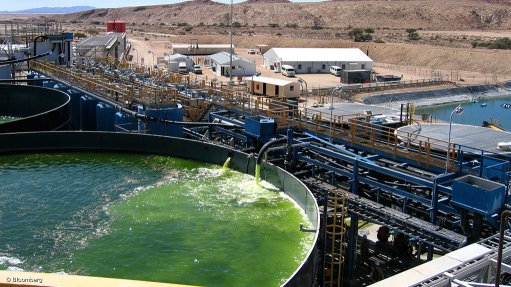
Photo by: Bloomberg
VANCOUVER (miningweekly.com) – Falling uranium prices are forcing dual-listed uranium miner Paladin Energy to cut back production even further.
The TSX- and ASX-listed miner on Wednesday announced that it was working on a proposed plan to reduce mining and mill throughput at the Langer Heinrich Mine (LHM), in Namibia, with processing plant feed coming from stockpiled low- and medium-grade ores.
Paladin said the revised mine plan effectively shifted higher-grade ore processing into later years when uranium prices were expected to be higher. For fiscal 2017, the average feed grade will be reduced to between 550 ppm and 570 ppm, from the previous internal company budget of 700 ppm.
The change will reduce finished uranium oxide (U3O8) output by between 1-million and 1.5-million pounds a year over the next two years. However, Paladin said the requirement for less movement of mined material on site during the period reduced cash operating costs more than any lost revenue.
Using Paladin's internal assumptions, the initiative will generate about $40-million of cumulative incremental operating cash flow for the 2017 and 2018 financial years. The proposed LHM mine plan adjustment requires a number of third-party consents and Paladin intends to initiate the plan in a phased approach over the next three months.
FY2016 RESULTS
Paladin Energy has narrowed its net loss for the year ended June 30, to $122-million, from $267.8-million a year earlier, as lower sales were offset by an 11% drop in C1 unit costs.
Core profit, as measured by the company’s earnings before interest, taxes, depreciation and amortisation (Ebitda) came in at $24.8-million, compared with the underlying loss before interest, taxes, depreciation and amortisation of $20.9-million a year earlier. Paladin attributed the improved performance to cost reduction initiatives that were implemented during the year.
C1 unit cost of production for the year was at a record low of $25.88/lb.
LHM, the company’s only current operating mine, produced 4.76-million pounds of U3O8 for the year, down 5% from 2015.
Sales revenue decreased by 7% year-on-year to $184.9-million, as a result of a 9% decrease in sales volumes, but partially offset by a 2% increase in the realised sales price. The average realised uranium sales price for the year was $37.75/lb of U3O8, compared with the average TradeTech weekly spot price for the year of $33.19/lb, a premium to spot of $4.56/lb.
According to TradeTech, the uranium spot price at the end of June was $26.80/lb, about 27% lower than at the end of June 2015.
Taking into account the proposed revised LHM mine plan, Paladin expects to produce between 3.8-million and 4-million pounds of U3O8 in the 2017 financial year, at a C1 cash cost of $19/lb to $22/lb.
Paladin, which owns 75% of the LHM, in July announced that it had signed a nonbinding term sheet to sell a 24% stake in the mine to a global nuclear power industry participant for $175-million. If concluded, Paladin will hold 51% of Langer Heinrich and continue to be the operator of the mine.
During the year, Paladin’s Kayelekera mine, in Malawi, remained on care and maintenance, with activities on site focused on the water treatment programme.